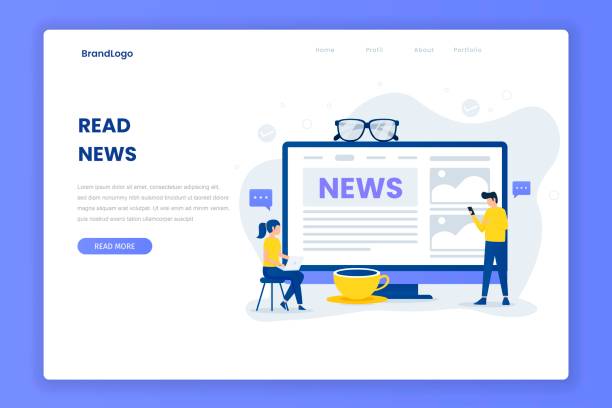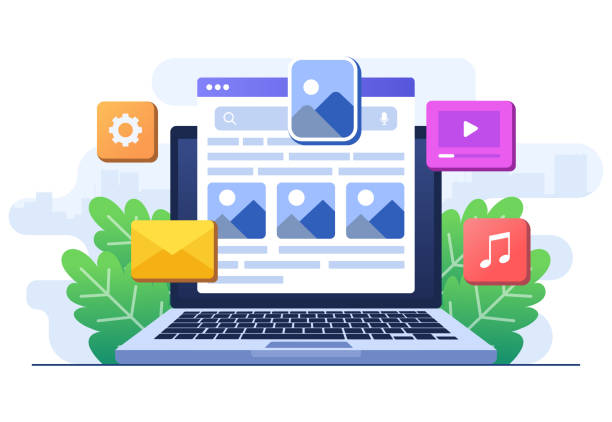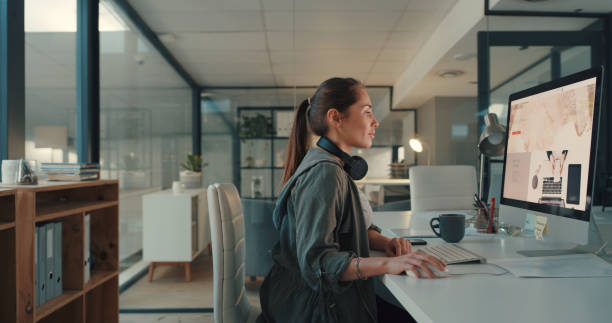Introduction to User-Friendly Website Design: Why is it Important?

In today’s digital world, merely having a website is not enough; your website must provide an unforgettable and enjoyable experience for your users.
This is where the concept of #user_friendly_website_design becomes important.
A #user_friendly_website is one where users can easily navigate, find the information they need, and achieve their goals.
The main objective in user-friendly website design is to focus on the users’ needs and expectations to ensure their interaction with the site is as optimal as possible.
This type of design goes beyond visual aesthetics, addressing deeper aspects such as accessibility, efficiency, and user satisfaction.
If your website is complex or users cannot easily interact with it, they will quickly leave and go to your competitors.
Therefore, a positive user experience (UX) not only increases user retention on the site but also improves conversion rates.
This approach ensures that every visitor, without any obstacles, can achieve their goal and enjoy interacting with your website.
Are you worried your company’s old website is scaring off new customers? Rasaweb solves this problem with modern and efficient corporate website design.
✅ Increases your brand’s credibility.
✅ Helps attract targeted customers.
⚡ Contact Rasaweb for a free consultation!
Key Principles of User-Friendly Website Design and Effective User Interface

To achieve user-friendly website design, several key principles must be considered.
The first principle is simplicity and clarity.
The user interface (UI) should be designed so that users can interact with it without special training.
Buttons and links should be clear and identifiable, and messages should be conveyed in simple, understandable language.
The second principle is consistency.
Visual and functional elements throughout the website should be consistent so that users feel familiar and comfortable.
For example, if a “back” button on one page is blue, it should remain the same color on all pages.
The third principle is appropriate feedback.
Users should always be informed of their current status on the website.
When they click a button, they should receive feedback (such as a button color change or a message display) indicating that their action was successful.
The fourth principle is user control and freedom.
Users should feel that they have control over their experience and can easily revert from their mistakes.
A powerful UX design provides easy and confusion-free navigation.
These principles form the foundation of a user-friendly interface site and significantly contribute to increasing user satisfaction and loyalty.
Understanding the Audience: User Persona Design

For user-friendly website design, a deep understanding of your target audience is crucial.
You cannot design for everyone and expect success.
The user persona tool is designed precisely for this purpose.
A user persona is a fictional representation of your real users, built upon accurate research data, including their age, gender, education, occupation, goals, needs, challenges, and even behavioral habits.
By creating detailed personas, designers can make more informed decisions about content, visual design, and site navigation structure.
For example, if your persona is an elderly person, you will need larger fonts and higher color contrast.
If it’s a teenager, they might be interested in a more modern design and dynamic interactions.
This approach ensures that your website’s user experience design directly benefits the end-users and improves their experience.
By thoroughly understanding these personas, you can design your site to meet the specific needs of each group and ultimately achieve truly user-friendly website design.
This approach is the foundation of any successful website with an excellent user experience.
| Persona Name | Age | Goals | Challenges | Design Needs |
|---|---|---|---|---|
| Young User (Omid) | 25 | Quick access to information, social interaction | Lack of fresh content, slow loading speed | Modern design, responsive, fast loading, sharing capabilities |
| Middle-aged User (Farideh) | 45 | Finding accurate information, online shopping | Complex navigation, small fonts | Simple navigation, readable font, clear and reliable information |
| Elderly User (Reza) | 65 | Reading articles, daily news | Small buttons, too many ads, low contrast | Plenty of white space, large buttons, high contrast, no pop-ups |
Information Architecture and Intuitive Navigation in Web Design

Information Architecture (IA) is one of the main pillars of successful user experience design and ultimately user-friendly website design.
This process involves organizing and labeling content in a way that users can easily find the information they need and navigate the website.
Poor information architecture can lead to confusion, frustration, and ultimately, users leaving the site.
To create a strong IA, a logical hierarchy for content must be established, clear and consistent naming conventions for categories and sections must be used, and intuitive navigation paths must be provided.
This includes designing menus, sitemaps, breadcrumbs, and search systems.
The goal is for users to always know where they are, how to get where they want to go, and how to go back.
An intuitive navigation system allows users to move through the site instinctively, without thinking.
This increases user efficiency and satisfaction and helps your site be recognized as a user-friendly designed site.
Focusing on this aspect will significantly increase visitor engagement.
Does your company website perform as well as your brand deserves? In today’s competitive world, your website is your most important online tool. Rasaweb, a specialist in professional corporate website design, helps you to:
✅ Gain credibility and customer trust
✅ Convert website visitors into customers
⚡ Get a free consultation now!
Combining Aesthetics and Efficiency: Visual Design and Usability

In website design, visual aesthetics and usability go hand in hand.
A site might be very beautiful, but if users cannot easily interact with it, it is practically useless.
Conversely, a site that is highly functional but not visually appealing might fail to attract users.
Therefore, the art of user-friendly website design lies in the intelligent combination of these two elements.
Visual design includes the choice of colors, fonts, images, and element layout, which must not only be attractive but also contribute to improving usability.
For example, using sufficient contrast between text and background for better readability, or using appropriate white space to reduce clutter and increase focus.
Usability means ease of use, efficiency, and user satisfaction from interacting with the site.
This includes designing clear buttons, simple forms, and logical workflows.
A strong graphic design that incorporates usability principles elevates the user experience to a higher level and makes your site a pleasant and efficient destination.
Responsive and Accessibility: Design for Everyone

In the current era where users access the internet from various devices, responsive design is a crucial aspect of user-friendly website design.
Responsive design means that your website should automatically adjust its layout and content to the user’s screen size (from desktop computers and laptops to tablets and smartphones).
This ensures that users have a consistent and optimized experience regardless of their device type, without having to zoom or scroll horizontally.
In addition to responsiveness, accessibility is also of high importance.
Accessible design means designing a website that people with diverse abilities, including those with disabilities, can easily use.
This includes providing alternative text for images, keyboard navigation, and ensuring compatibility with screen readers.
By integrating these two elements, your website will not only be accessible to all users but will also provide a positive user experience for a wide range of visitors, which is one of the main pillars of excellent UX design.
Testing and Iteration for Sustainable User-Friendly Website Design

No user-friendly website design is perfect on the first try.
Website design is an iterative process that involves testing, gathering feedback, and continuous optimization.
Usability Testing is one of the most effective methods for identifying the strengths and weaknesses of your design.
In this process, real users interact with your site, and you observe and record their behavior, opinions, and problems.
These tests can be conducted in-person, remotely, or using eye-tracking tools and mouse movement analysis.
The results of these tests provide valuable insights that help you make the necessary changes to improve the user experience.
In addition to usability testing, analyzing website data (such as bounce rate, time on page, and navigation paths) can also help you understand user behavior patterns and make data-driven decisions.
This analytical approach ensures that your design continuously improves and responds to evolving user needs.
A site with continuous improvement capability is always progressing and offers the best experience.
| Test Method | Description | Advantages | Disadvantages |
|---|---|---|---|
| Moderated In-Person Testing | User interacts with the site in the presence of an observer and vocalizes their thoughts. | Deep insights, direct Q&A possible | Expensive, time-consuming, requires physical location |
| Unmoderated Remote Testing | User interacts with the site in their own environment, and their actions are recorded. | Scalable, cheaper, access to a wider range of users | No direct questioning, requires more precise analysis |
| A/B Testing | Two different versions of a page are shown to users to compare their performance. | Direct and quantitative, data-driven optimization | Only for small changes, requires high traffic |
| Surveys and Feedback Forms | Collecting direct user opinions through questionnaires or online forms. | Fast and inexpensive, gathers qualitative feedback | No observation of real behavior, bias in responses |
Content is King: The Role of Content in User Experience Design

In the discussion of user-friendly website design, the focus is often on visual and technical aspects, but the vital role of content should not be overlooked.
Content is king; because users visit your website to find information, entertainment, or solve their problems, and it is your content that fulfills these needs.
High-quality, relevant, and organized content not only increases the value of your site but also directly impacts the user experience.
Engaging content can encourage users to stay on the site longer, reduce bounce rate, and ultimately help increase conversions.
For an optimal user experience, content should be readable, understandable, and easily scannable.
Using headings, short paragraphs, lists, and relevant images can significantly improve readability.
Also, the tone and language of the content should be appropriate for the target audience.
Video and interactive content can also be highly entertaining and help increase user engagement with the site.
Therefore, any strategy for successful UX design must include careful content planning to make the website a valuable and attractive resource for users.
Is your online sales not meeting expectations? With Rasaweb, permanently solve the problem of low sales and poor user experience!
✅ Increase visitor-to-customer conversion rate
✅ Create an enjoyable user experience and build customer trust
⚡ Get a free consultation now!
The Convergence of SEO and User-Friendly Website Design

In the past, SEO (Search Engine Optimization) and website design (especially the UX part) were often considered two separate fields.
However, today it has become clear that these two are completely interdependent and convergent.
Strong SEO helps your site be visible in search results, but a user-friendly website design is what keeps visitors on the site and helps them achieve their goals.
Search engines like Google are increasingly emphasizing user experience factors for ranking websites.
Page loading speed, responsiveness, easy navigation, quality content, and low bounce rate are all factors that are important for both users and SEO.
When users have a good experience on your site, they spend more time on it, view more pages, and are more likely to return to your site.
These signals indicate to search engines that your site is valuable and relevant, thus increasing its ranking.
Therefore, focusing on UX and UI design is not only beneficial for your users but also a smart strategy to improve your site’s SEO and helps you stand out in the competitive online world.
The Future of User-Friendly Website Design and Upcoming Challenges

User-friendly website design is a dynamic and evolving field that is constantly changing with technological advancements and shifting user expectations.
The future of UX and UI design will see more innovations that take the web interaction experience to the next level.
Artificial intelligence and machine learning will play an increasingly important role in personalizing the user experience, allowing websites to automatically adjust content and layout based on each user’s interests and behaviors.
Virtual reality (VR) and augmented reality (AR) also offer new opportunities for more immersive and engaging interactions.
Furthermore, the emphasis on audio design and voice user interfaces (VUIs) is growing with the proliferation of voice assistants.
However, with these advancements, challenges also arise, including maintaining user privacy, ensuring accessibility for all despite more complex technologies, and managing large volumes of data.
Designers must continuously update their skills and keep pace with new trends to be able to continue providing innovative and effective user experiences.
The main question is: How can we keep up with this pace of change and still create designs that truly meet human needs?
Frequently Asked Questions
And other advertising services of Rasaweb Advertising Agency in the field of advertising
Smart Social Media: An effective tool for online growth through marketing automation.
Smart Content Strategy: A novel service to increase customer attraction through dedicated programming.
Smart Custom Software: A novel service to increase user engagement through SEO-driven content strategy.
Smart Data Analysis: Designed for businesses seeking to manage campaigns through Google Ads management.
Smart Website Development: A fast and efficient solution to increase website traffic with a focus on smart data analysis.
And over hundreds of other services in the field of internet advertising, advertising consultation, and organizational solutions
Internet Advertising | Advertising Strategy | Advertorials
References
Principles of User-Friendly UI/UX Design
Key Tips for User-Friendly Website Design
Secrets of Successful and Practical Website Design
Guide to Building a User-Friendly Website from Scratch
💡 With Rasaweb Afarin, your business gets a new lease on life in the digital world. We specialize in secure website design, search engine optimization (SEO), and online advertising campaign management, accompanying you on your path to success.
📍 Tehran, Mirdamad Street, next to Central Bank, Kazeroon Jonoubi Alley, Ramin Alley, Plaque 6

